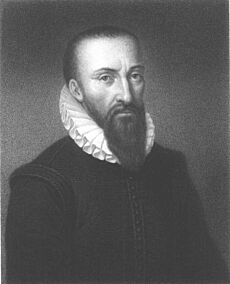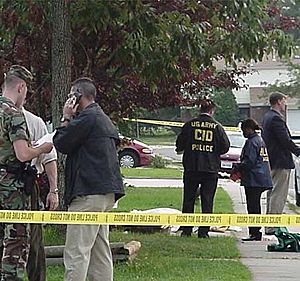Forensic science facts for kids
Forensic science (often just called forensics) is a special field that uses science to solve crimes. It involves finding, keeping safe, and studying clues (called evidence) from places where a crime happened.
Common clues found include fingerprints. Scientists also look for other tiny things like a few hairs or small pieces of skin. These can be used for DNA testing, which helps identify people and even tell their gender. When someone is suspected of a crime, these clues can be compared to them. If they match, it helps prove who committed the crime.
Some forensic scientists go to crime scenes to collect evidence themselves. Others work in labs, studying the items brought to them. There are also experts who analyze money, bank records, or other numbers to help investigate financial crimes. They might work for private companies, universities, or the government.
Besides their lab work, forensic scientists often speak in court as expert witnesses. They explain their findings in both criminal and civil cases. They can work for either the side trying to prove guilt (the prosecution) or the side defending the accused.
History of Forensics
Long ago, people didn't have official ways to investigate crimes. This often made it easy for criminals to get away with things. Back then, solving crimes and trials mostly relied on forcing people to confess or on what witnesses said. However, some old stories show ideas that were like modern forensic science.
The first known book about using medicine and entomology (the study of insects) to solve crimes was written in China in 1248. It was called Washing Away of Wrongs (Xi Yuan Lu) by Song Ci. He was a director of justice during the Song dynasty.
Song Ci created rules for how to write reports about dead bodies (autopsies) for court. He also explained how to protect evidence during an examination. He stressed that forensic workers must be fair to everyone. He even found ways to make things clean (antiseptic) and to show hidden injuries on dead bodies and bones using sunlight and vinegar. He also figured out how to guess the time of death based on weather and insect activity. This book was the first of its kind to help figure out why someone died.
Around the world, people used different methods to tell if someone was innocent or guilty. Some involved checking saliva, the mouth, or the tongue. In ancient India, suspects had to fill their mouths with dry rice and spit it out. In ancient China, rice powder was placed in their mouths. In ancient Middle Eastern cultures, accused people briefly licked hot metal rods. It was thought that guilty people would be more nervous, produce less saliva, and have a drier mouth. So, if rice stuck to their mouths or their tongues burned, they were seen as guilty.

In Europe during the 1500s, doctors in armies and universities started collecting information about how and why people died. Ambroise Paré, a French army surgeon, carefully studied how violent deaths affected body parts. Two Italian surgeons, Fortunato Fidelis and Paolo Zacchia, began the study of modern pathology. This is about how diseases change the body's structure. Later, in the late 1700s, books on these topics appeared. These included A Treatise on Forensic Medicine and Public Health by French doctor Francois Immanuele Fodéré.
As new ideas about reason and evidence spread in the 1700s, crime investigation became more scientific. Forced confessions were used less, and beliefs in magic no longer affected court decisions.
In 1885, an article in Scientific American described using a microscope to tell the difference between the blood of two people in a criminal case in Chicago.
Types of Forensic Science
Forensic science has many different branches, each focusing on a specific type of evidence or area of study:
- Forensic accounting looks at money and financial records to find clues about financial crimes.
- Forensic anthropology uses the study of human bones to identify people, especially from skeletal remains.
- Forensic archaeology combines methods from archaeology and forensic science, often used by police.
- Computational forensics creates computer programs and tools to help with forensic exams.
- Criminalistics uses different sciences to answer questions about biological evidence (like DNA), trace evidence (tiny bits of material), and other clues. This includes fingerprints, shoe prints, tire tracks, controlled substances, and ballistics (the study of firearms). This work often happens in a crime lab.
- Forensic dactyloscopy is the study of fingerprints.
- Digital forensics uses scientific methods to get data from computers and other electronic devices. Digital forensic experts work both in the field and in labs.
- Forensic document examination (or questioned document examination) answers questions about documents that might be fake or changed. This often involves comparing a questioned document to known examples, like checking handwriting to see who wrote it.
- Forensic DNA analysis uses the unique DNA of each person to solve crimes. It can help with paternity tests or place a suspect at a crime scene.
- Forensic engineering examines structures and products to find out why they failed or were damaged.
- Forensic linguistics deals with legal issues that need language expertise.
- Forensic pathology uses medical methods, including autopsies, to figure out the cause of death or injury in legal cases.
- Forensic psychology studies the mind of a person using forensic methods. It often helps understand why a criminal behaved a certain way.
- Forensic toxicology studies the effects of drugs and poisons on the human body.
- Forensic Podiatry applies the study of feet, footprints, or footwear and their marks to analyze crime scenes and identify people.
Images for kids
-
The front page from Bertillon's book Identification anthropométrique (1893), showing how he measured people for identification.
-
Fingerprints taken by William Herschel between 1859 and 1860.
-
Women working for the LA Police Department getting their fingerprints and photos taken in 1928.
-
The famous fictional detective Sherlock Holmes was very advanced for his time in how he used forensic analysis.
-
Alec Jeffreys invented the DNA profiling technique in 1984.
See also
 In Spanish: Criminalística para niños
In Spanish: Criminalística para niños









